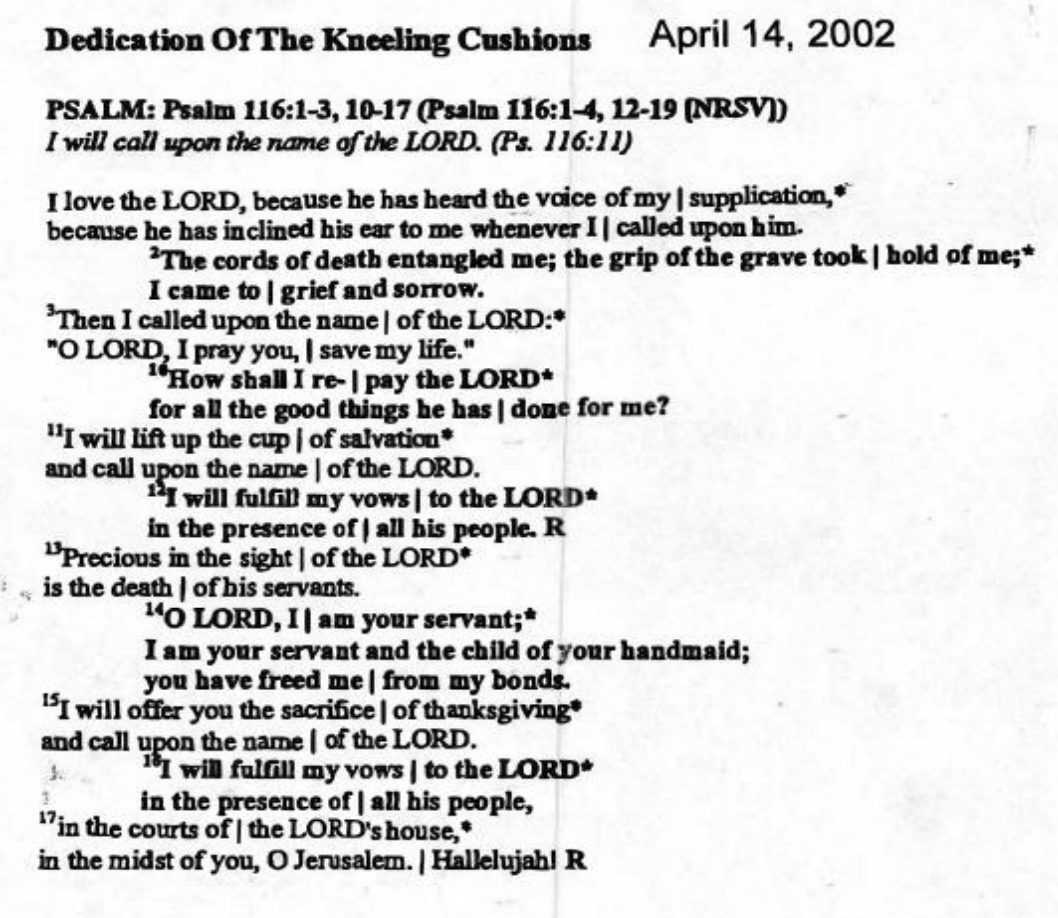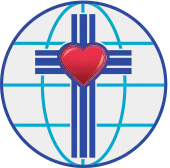A SEED IS PLANTED. . .
On November 6, 1951, a group of 22 Lutherans held a meeting at the Leesburg Recreation Center with the Reverend A. M. Himes, D. D., of Fruitland Park, FL and the Reverend Martin L. Swanson of Zion Lutheran Church in Groveland, FL to discuss the viability of a Lutheran church in Leesburg. Those in attendance began services on Sunday, November 25, 1951 at the Woman's Club of Leesburg. On April 27, 1952 the congregation began to worship in the upstairs auditorium of the Lassiter-Ware Insurance Building in downtown Leesburg. Sunday School classes began as well.
Gloria Dei Lutheran Church continued to grow under the guidance of Duane Carlson, an intern from the Augustana Theological Seminary in Rock Island, IL. It was officially organized on October 26, 1952, as a mission of the former Augustana Evangelical Lutheran Church with 48 adult and 15 child members.
The charter membership roll was closed on January 1, 1953 with 50 charter members. On January 21 of that same year at the first annual congregational meeting, the congregation voted to purchase a lot at 130 Lone Oak Drive. At one time this was the location of a depot where Spanish tree moss was collected and shipped north to the Fisher Body Corporation in Detroit to make "horse hair" stuffing for automobile seats. The congregation decided to build as soon as possible.
Just 18 months later on December 12, 1954, the new church building was dedicated by the Reverend Thorston Gustafson, D.D., President of the New York Conference of the Augustana Lutheran Church. The cornerstone was laid by the Reverend Arne Andell, President of the Florida District of the Augustana Lutheran Church. A copper box containing the history of the congregation, a hymnal, newspaper reports, and the charter membership list was placed in the cornerstone. By the end of 1954, the Parish Record listed 88 members and 59 enrolled in the Sunday School. This was an increase of 83% in adults and almost 400% in children in just two years. The Baby Boomers had arrived!
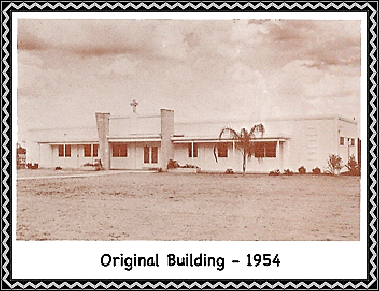
The '60s
In 1962, the year of Gloria Dei's 10th anniversary, the Augustana Evangelical Lutheran Church joined with three other Lutheran church bodies to become the Lutheran Church in America. Since Gloria Dei was a member of the Florida District of the Augustana Lutheran Church, the name was formally changed to Gloria DeiEvangelical Lutheran Church.
Growth in Leesburg was reflected in Gloria Dei's full pews. A second service was added to the regular 9:30 a.m. service. Gloria Dei attracted not only full-time members, but also seasonal members from the North.
The 70's
The physical church continued to change to accommodate the growth of the congregation. Among the most notable changes was the addition of a gabled roof, a narthex, additional pews and the first organ.
Gloria Dei's outreach ministry was increased to include World Hunger Appeal, Lutheran World Relief, sponsorship of several children in other countries, and the benevolence work of the Mary-Martha and Dorcas circles.
Gloria Dei reflected the change in the surrounding community with the recent influx of "snowbirds" into the area. These seasonal worshipers wanted to fully participate in Gloria Dei's rich spiritual life and Gloria Dei welcomed them with enthusiasm.
A Welcome Desk was implemented in the narthex where visitors were greeted by an usher and asked to sign the guest book.
In 1977, Gloria Dei celebrated its 25th anniversary.
The '80s
Reverend Wallace Kemp arrived to shepherd Gloria Dei for the next 20 years until he retired in 2000. Gloria Dei added changes to the existing structure including a new sanctuary and a complete lower floor for offices, meeting rooms, and storage areas.
Gloria Dei established a memorial garden, which is maintained by members of the church.
The 90's
Gloria Dei happily burned the real estate mortgage and companion in the church parking lot in March 1990. As an indication of the sign of the times, Gloria Dei had their first women ushers! A pictorial church telephone directory was produced for the first time.
Dedication of the bronze church bell was rung for the first time on December 27, 1992. It was originally cast in 1892 and formerly hung in Philadelphia, which made it exactly 100 years old when it was installed at Gloria Dei. The bell continues to be rung before worship services, funerals, and weddings.
Renovations continued to be made including installations of stained glass windows in the narthex that were made possible by donations of Gloria Dei members. The Living Christ life-sized wood sculpture in the sanctuary was installed.
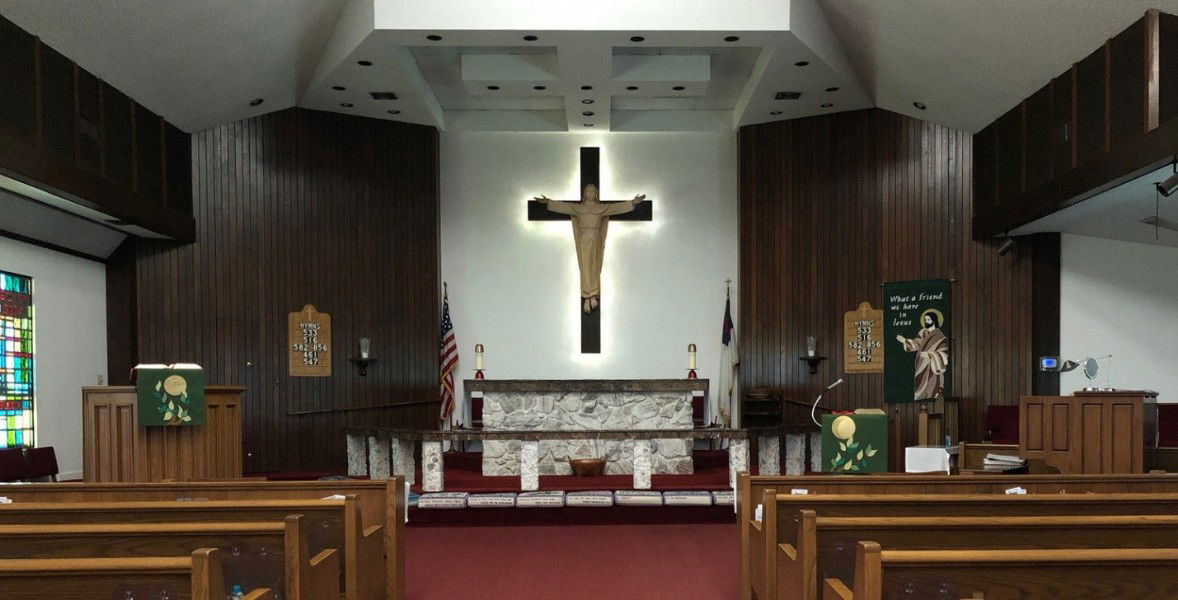
Members of the congregation worked on needlepoint cushions using designs created by church member Robert Terry. The themes include the seven last words of Christ, Psalm 1, and a summation of our journey of faith through the church year.
Gloria Dei expanded its outreach by participating in building a house with Habitat for Humanity and the Angel Tree project, which provides gifts and food to children who have a parent in prison. Other projects, such as the Pig Project for Haiti, provided pigs to the poorest of the poor enabling them to become self-sufficient.
A series of musical concerts took place with music ranging from black gospel music to violin concerts. All concerts were well attended. In 1994, the congregation voted to purchase a Baldwin Organ, which was replaced for a newer model in February 1997.
A Columbarium Chapel was constructed in 1998 for use by members and their families.
Several seminary scholarships were funded for a number of students and missionary ministries in Africa continued to be supported.
2000's
"The Purpose Driven Church" seminar, which is a structured approach to change and a new identity, was conducted and attended by over 100 church members.
Communicants are given the choice of receiving communion wafers or bread and an Altar Guild is organized and a Fellowship Committee will organize social events throughout the year. The newsletter receives a new name: The Glorion. The name signifies that the Glory of this House of God will go on for many generations to come.
Gloria Dei has its first website and Gloria Dei continues to fund scholarships for seminarians. A Nursery/Wee Worship for small children is instituted during worship. The church sound system is updated.
In 2001, Gloria Dei begins a year-long 50th anniversary celebration that kicked off with a sermon delivered by the Bishop of the Florida-Bahama Synod and an anniversary dinner at Silver Lake Country Club.
New doors at the entrance to the church were installed and painted red. A series of piano and organ and choral concerts continue to be offered and are well attended by the congregation.
An Altar Guild was established in 2001 and has the responsibility of maintaining the main altar in the sanctuary as well as the altar in the Columbarium.
The Memorial Garden was renovated and a memorial stone was installed. It is inscribed with the names, dates of birth and death of persons whose cremains are placed in the Memorial Garden.
Pastor Thomas S. Church accepts the call to become pastor of Gloria Dei Gloria Dei in 2002.
Gloria Dei once again participated in building several houses in conjunction with Habitat for Humanity. Members raised nearly money and gave hours of labor to these projects.
Gloria Dei approved a new shorter mission statement: "Gathering in Christ…Sharing His Love," which is printed on the inside cover of the Glorion monthly newsletter.
Renovations continued to take place with changes made to the kitchen, Fellowship Hall, and the conversion of the former choir room to a vestry for the pastor and assistant ministers to robe.
A bronze Living Memorial was installed in May 2004 and is located to the left of the center doors leading into the sanctuary. A gift of $1,000 per name on the plaque is invested in the Mission Investment Fund of the Evangelical Lutheran Church. These fund are used to begin new missions in the ELCA.
2010 – Present
In 2013 Gloria Dei continued its outreach efforts by collaborating with First Presbyterian Church of Leesburg (our next door neighbor) to form Joining Hands in Food Ministry (JHIFM) to feed the hungry in Leesburg. Volunteers from both churches join hands on the second Friday of every month at Gloria Dei Lutheran Church from 9:30 to 11:30 a.m. to feed local families in need. Each family is given enough food to last a week. JHIFM is an authorized partner agency of Second Harvest Food Bank of Central Florida, and a 2018 Grant Recipient of the United Way of Lake and Sumter Counties. Gloria Dei Thrivent Financial members use their Action Team grants to fund $250 of food for each month. Thanks to a bequest from a GDLC member, a new van was purchased in 2017.
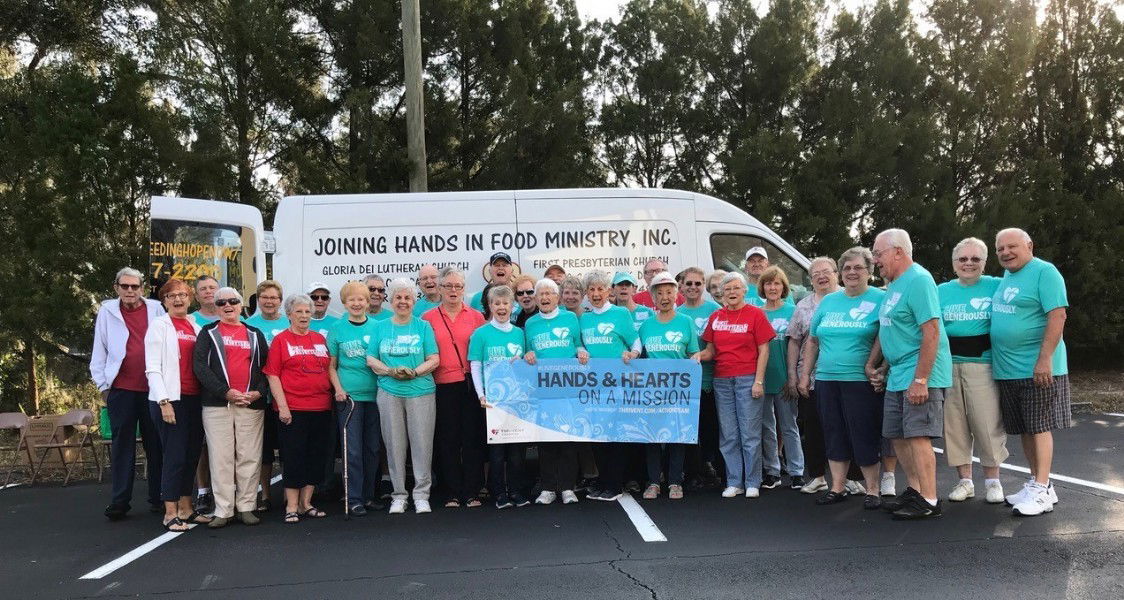
Gloria Dei partners with The Salvation Army in a number of projects. The Christmas Angel Project is a partnership with the Salvation Army to provide gifts for children and seniors. The Community Hunger Project supplies several thousand pounds of food to the Salvation Army's emergency food supply. Souper Bowl provides cans of soup and bags of crackers for the hungry. Blankets and sweaters are provided to the Salvation Army for distribution to the homeless and those with inadequate heat during cold spells.
The youth of the Leesburg community are a continuing project for Gloria Dei. The Book Buddies after School Project encouraged members to share a snack with a child and share a story by reading one-on-one with a child. Children across the globe benefited from the Samaritan purse Christmas Shoe Box Project, which provides toys and clothes. School supplies drives for Oak Park Middle School in Leesburg are a successful annual event every fall. The Priscilla Circle addresses other needs at the school as they arise. Gloria Dei contributes food to the Backpack after School Program, which provides weekend food supplies to children who participate in the school Free Lunch program.
Gloria Dei supported a mission church in Wildwood, FL, which eventually became Rock of Ages Lutheran Church. Gloria Dei assisted a volunteer in the new church to become a minister. Gloria Dei also supported Lutheran Outdoor Ministries for "camperships and Luther Springs Activities.
Many of these outreach projects are carried out in conjunction with Thrivent Financial. Members apply for Action Team Projects and Thrivent donates $250 for each project.
WELCA continues to provide assistance to victims of worldwide assistance in the form of beautiful handmade quilts. Over 300 quilts a year are donated to Lutheran World Relief as well as to several local charities. WELCA also sponsors "Rachel's Day," a day in recognition of abused and battered women and children.
Gloria Dei began its participation in the Lutheran World Relief Coffee Project that supports small-scale farmers and the environment. This coffee is used for church gatherings and is also available for purchase for use in the home.
The Welcome Desk continued to be refined with the addition of a welcome bag filled with goodies, such as a newsletter, Pastor Marilyn's contact card, a Gloria Dei brochure, information about the Joining Hands in Food Ministry, the Lord's Prayer bookmark, and a Gloria Dei pen. The most popular item in the bag is the packet of M&Ms that represents Missional Ministries.
In 2015, Funeral Plan booklets were implemented and made available to GDLC members to complete. These books contain information about funeral wishesmaking it easier for survivors of the deceased. Members retain a copy and another copy is kept in the church office.
Gloria Dei participated in the Traveling Martin Luther (aka Flat Luther) project, which was a fun way to keep Martin's Good News message of God's grace moving. Congregation members enjoyed taking small paper figures of Martin on vacation and to church activities.
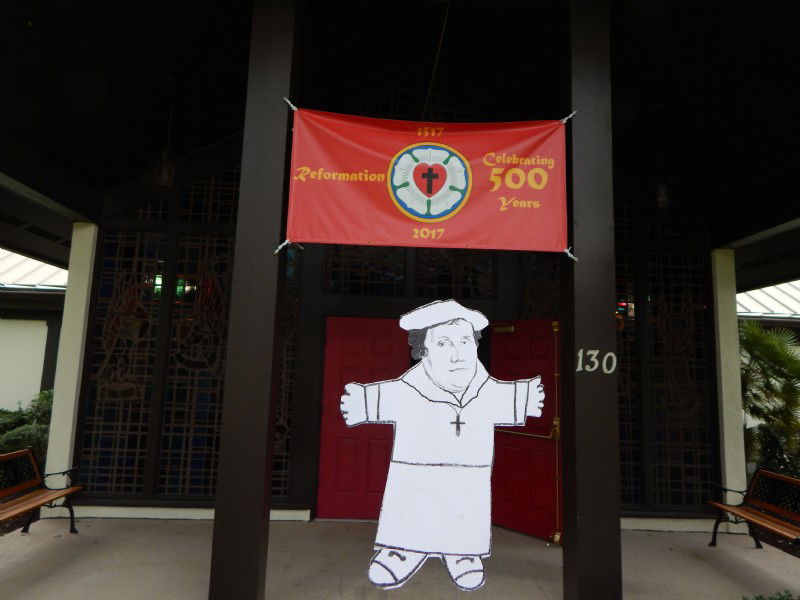
This was in conjunction with the 500th anniversary of the Reformation that was celebrated on Sunday, October 31, 2017.
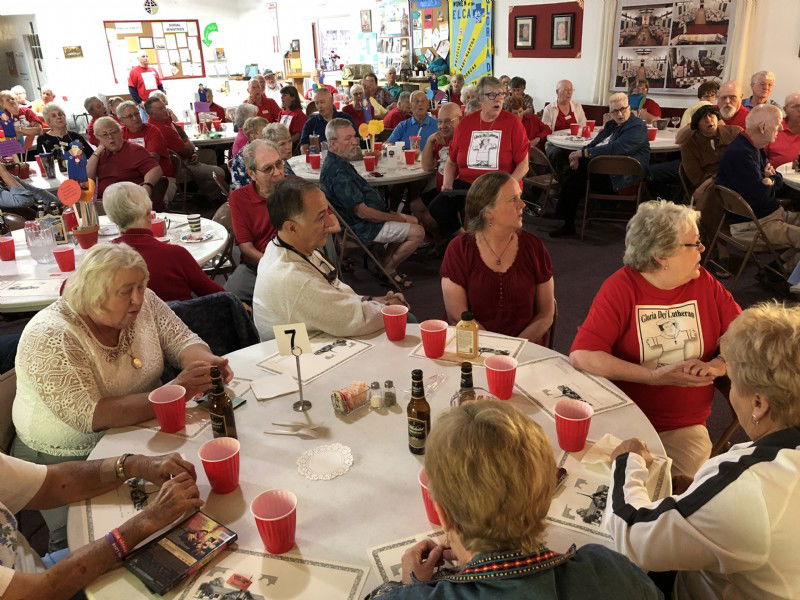
Gloria Dei members also make time to have fun. The social time after worship continues to be well attended.
In 2016 Paul Motto joined Gloria Dei as the new organist and music minister. In addition hearing enhances were purchased to asst people with hearing aids who still have difficulty hearing the worship service.
Periodic events such as Mardi Gras, Bingo, and Octoberfest give us all the opportunity to enjoy time with each other.
In 2018, a multimedia sign was installed in front of the church. Its colorful graphics highlight the many activities and sermon series that take place at Gloria Dei.
In 2020 Gloria Dei upgraded the fire alarm system to meet fire code.
Also various building and grounds improvements were made, including landscaping, painting, a new chandelier in the entry, a new badge holder and accommodations for the Covid 19 restrictions. These were adding sanitizing stations, plastic in front of desks, new arm opening handles on doors and requiring a mask be worn and social distancing be maintained. Other Covid accommodations were conducting services on Zoom, holding communion services in the parking lot, devising a coffee hour on Zoom for socializing, and conducting meetings on Zoom. The Call Committee met nearly every week beginning in April, 2020, while observing these Covid restrictions. Christmas Eve service was held in the parking lot in December, 2020.
Bob Keim was hired in summer 2020 as Maintenance Supervisor and Paityn Miller was hired in February 2021 to be our new webmaster. Paul Motto, organist retired. An audiovisual booth was added in 2021 to run the live streaming of church services. Pastor Ed Barnett's first sermon was June 13, 2021. Our new parish musician, Charlene Cranmer, was hired September 1, 2021. Pastor Barnett's last service was in July of 2024 before relocating to another church, and Charlene Cranmer relocated to another church September 15, 2024. Evelyn Rollins was hired as office manager in July of 2024, replacing Mary Beth who retired in June of 2024. Pastor Lynn Fonfara joined Gloria Dei August of 2024 serving as Interim Pastor. Len Cremisio was hired as as the music director and started serving September 29,2024.
Below is a list of pastors who have blessed and guided Gloria Dei through the years:
1951-52
Albert M. Himes
1952-53
Duane Carlson (Seminarian)
1952
Martin L. Swanson
1952-53
Duane Carlson (Seminarian)
1954
H. Allison Linne
1954-58
Evans M. Carlson
1959-61
Dale C. Holt
1961-65
Duane H. Sandstrom
1966
James H. Goss
1969-72
Albert W. Keyser
1972-74
William C. Kaiser
1974-78
Charles P. Snyder
1979-2000
Wallace Kemp
2000
Richard L. Baker (Interim)
2001-2012
Thomas S. Church
2012
Roy Stackpole (Interim)
2013
Marvin Oechler
August, 2014 - May, 2019
Marilyn Crosby
May, 2019 - June, 2021
James Young
June, 2021 - July, 2024
Ed Barnett
August, 2025 - Present
Lynn Fonfara (Interim)
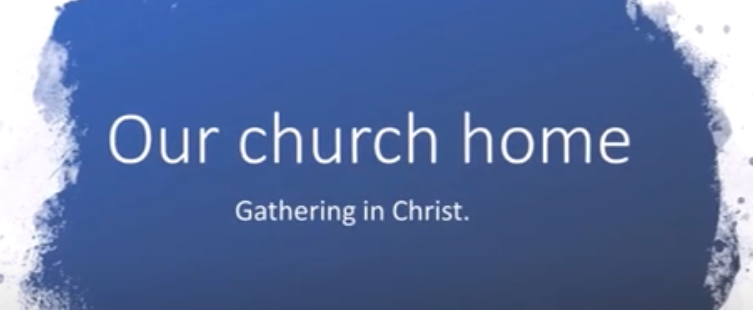
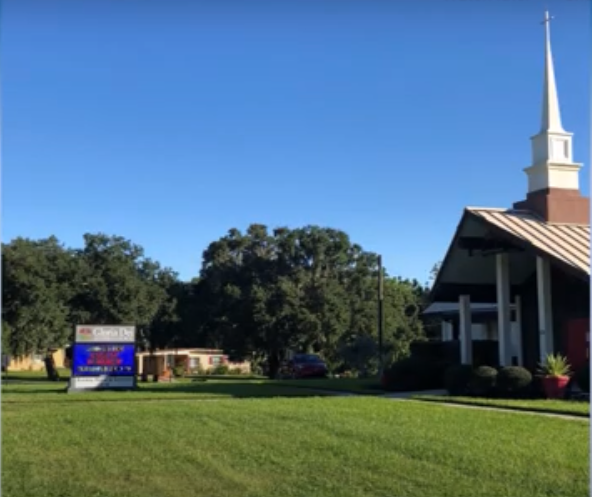
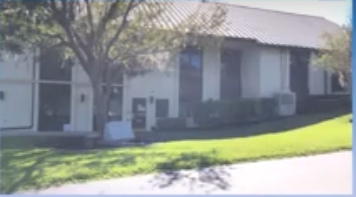
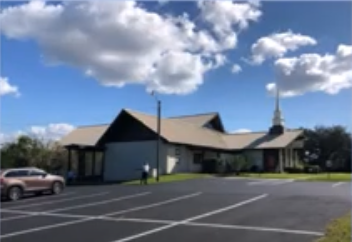
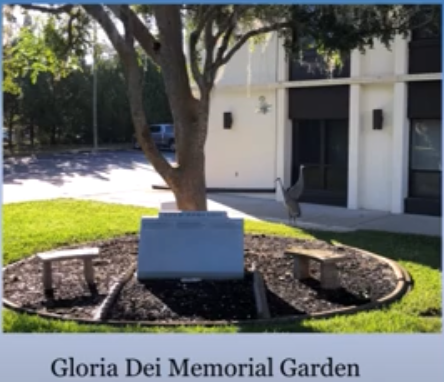
Columbarium / Chapel
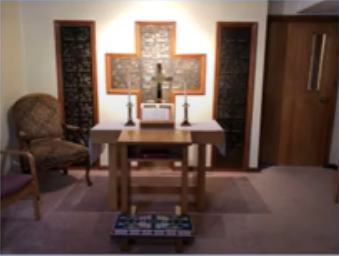
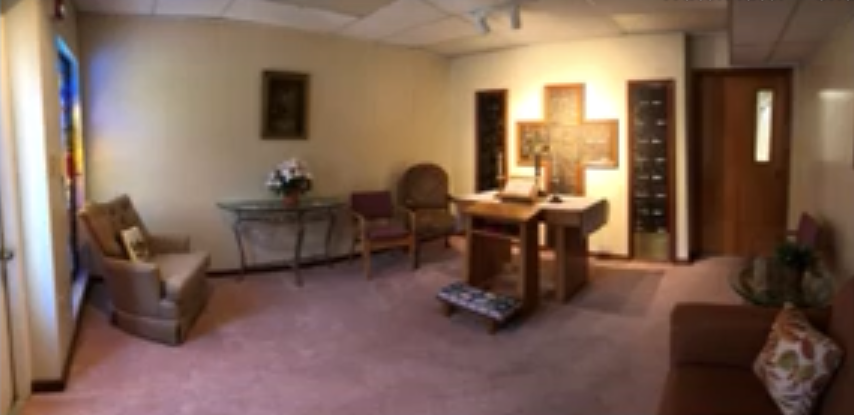

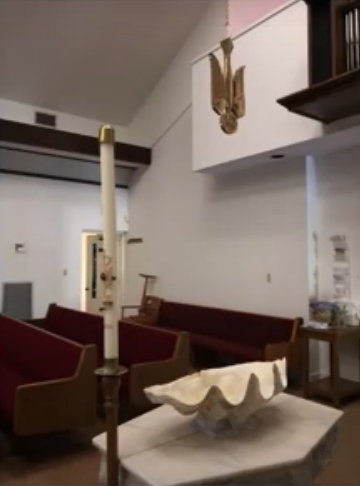
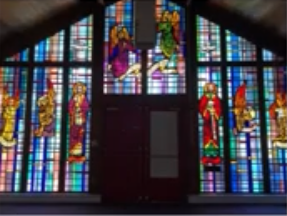
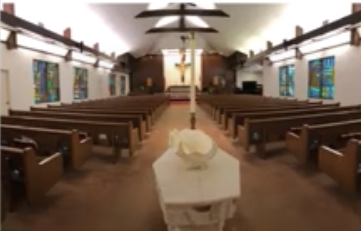
Our Stained Glass Windows
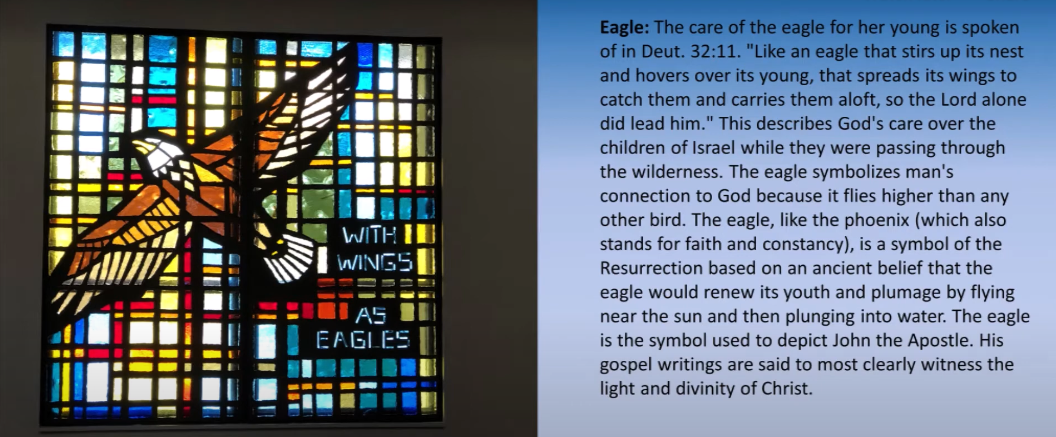
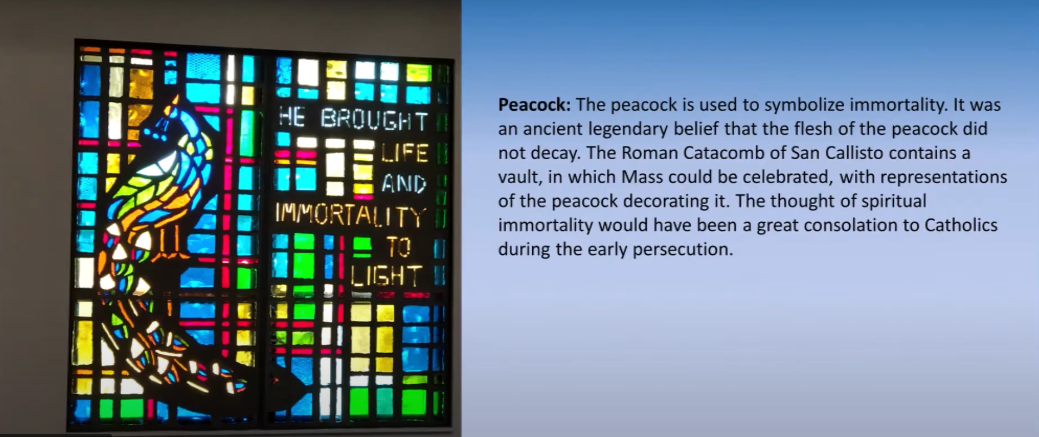
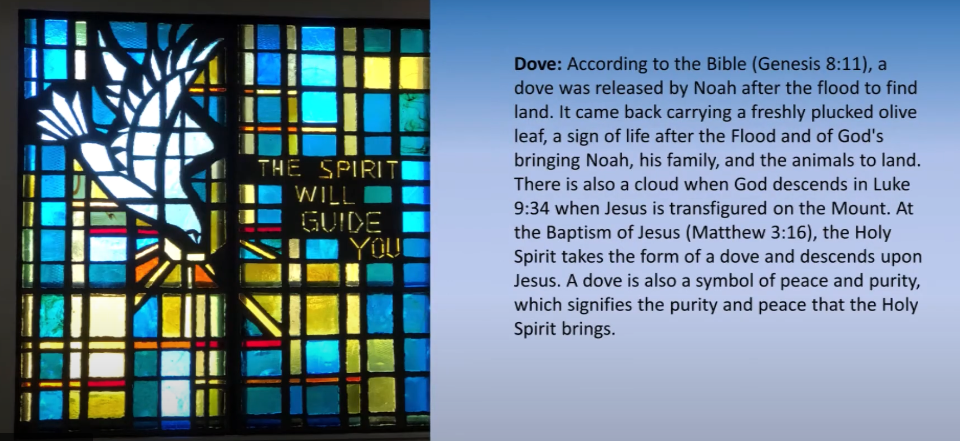
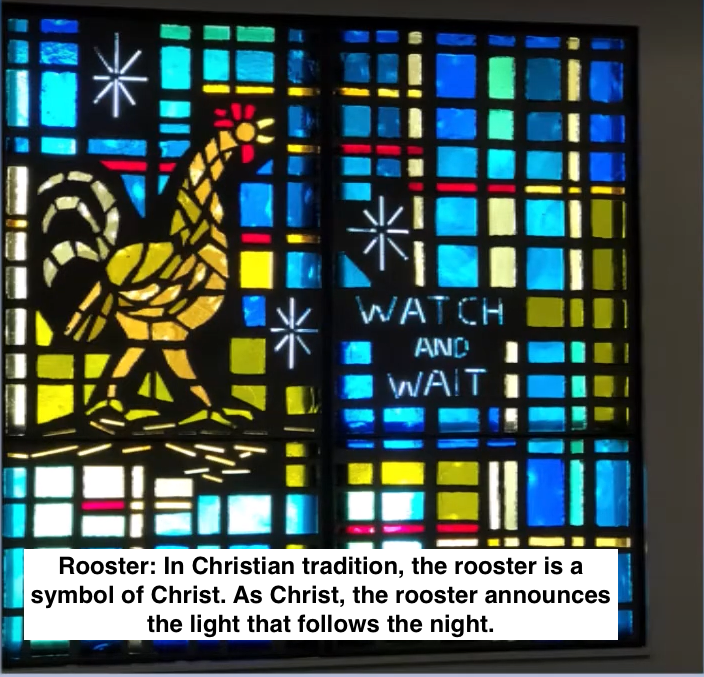
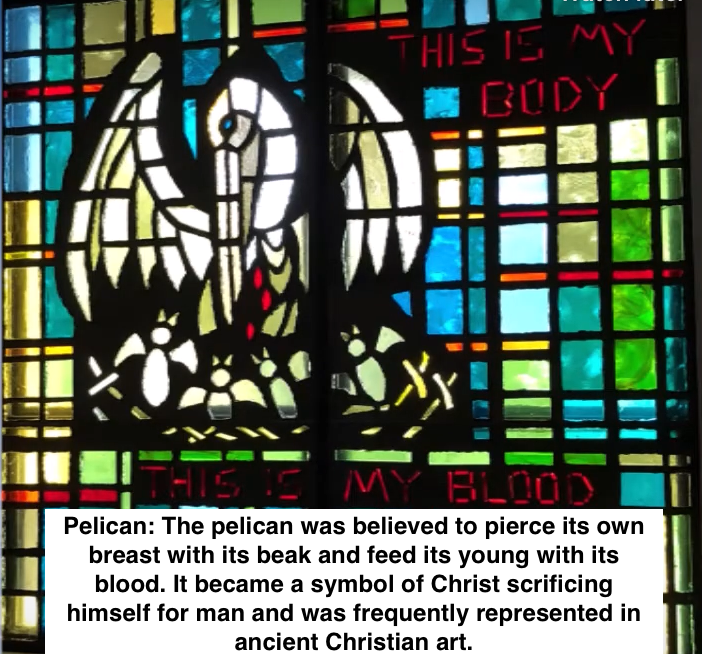
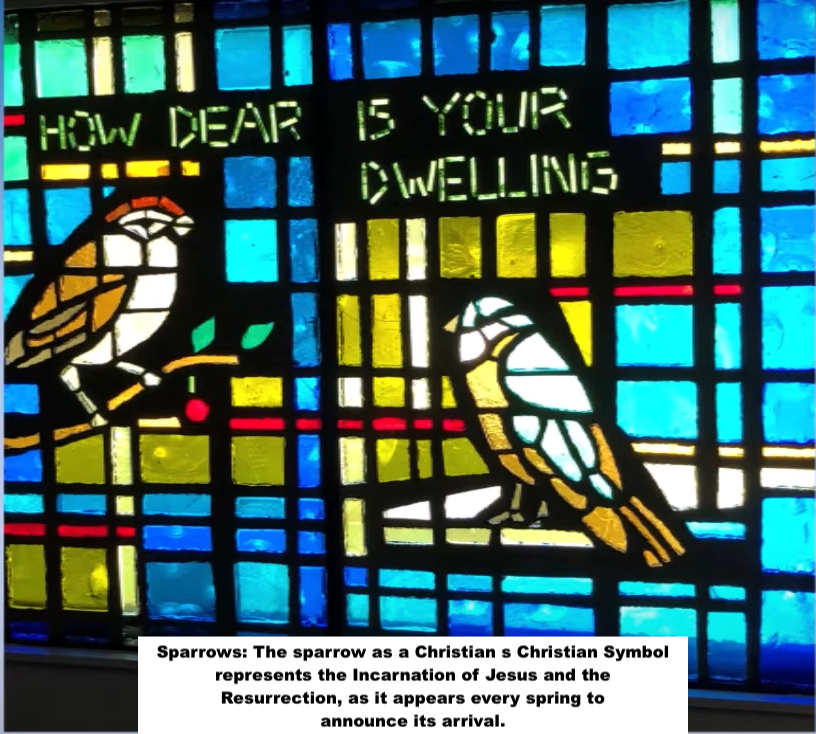
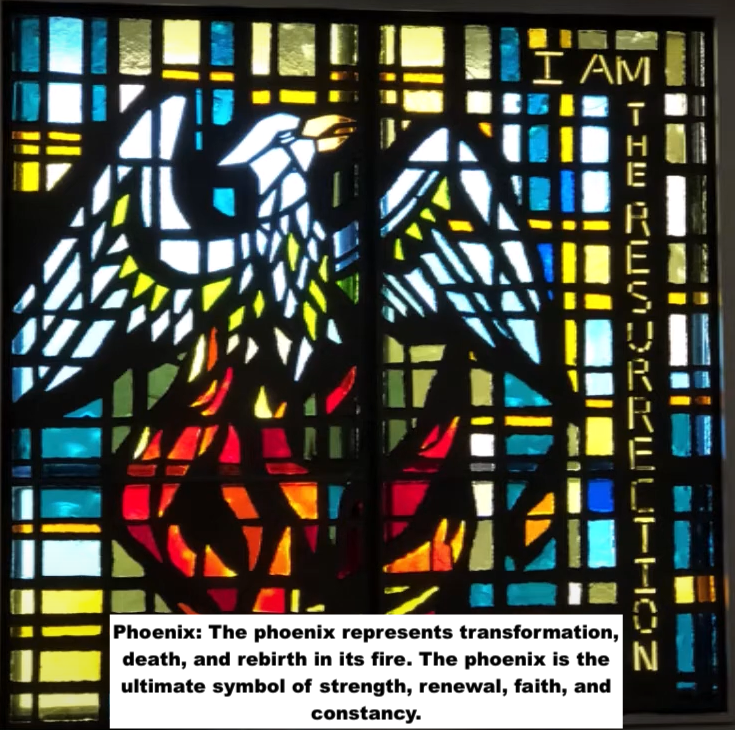
The Needlepoint Kneeling Cushions
Sometime in the spring of 1998, a small group from our choir wanted to learn to do needlepoint. I had done needlepoint design and taught technique before, so we decided that we would meet before choir rehearsal. The class went well and continued throughout the summer. Everyone was working on individual projects, pictures, pillows, ornaments - that sort of thing. In the fall, I mentioned that we might do a project for the Gloria Dei. When I suggested doing kneeling cushions for the altar, a chord was struck. Pastor Kemp and the Council approved our project and work began.
As it seemed more practical to allow everyone to have a portion of the altar rail which they could take home to work on, we decided to create nineteen individual kneelers to replace the three existing ones. The number nineteen was arrived at because that is the number of communicants which fit comfortably around the altar rail for each table of Holy Communion. There would be six cushions each on the right and left sides, and seven across the front. The number seven played an important part in the design process.
The seven kneelers across the front, I thought, should represent the seven last words of Christ spoken from the cross as set forth in the four Gospels. The Old Testament would be seen on the left using a paraphrase of Psalm 1. And on the right, a summation of our journey of faith through the church year. The only problem left was the nature of the individual designs. I felt that random renditions of common Christian symbols would not be appropriate. From the first day I entered the sanctuary, I was struck by the beauty and symbolism of the birds in the stained-glass windows. The eagle which of all birds could soar the highest, the pelican who would pluck life-giving blood from her own breast to save her young from starvation, and the others - all strong symbols of dedication, strength and sacrifice. In keeping with nature, I started to remember many of the trees and flowers which held meaning as strong of that of the birds.
And so the drawing ended, ending in what you see around the alter. Most of the symbolism dates back to the Renaissance and the masters, greater and lesser, who used the symbols in their paintings, frescoes, tapestries, vestments, paraments - any place where beauty would enlarge their visual prayer.
So much for the design work. On to the ladies and, yes, gentlemen who did the actual stitching. None of the canvasses were charted or painted. The entire design consisted of a line drawing to be interpreted by the stitcher using a variety of colored tapestry wool. Each stitcher had to make the canvas come to life using the varied shades of yarn. And they had to use diagonal tent stitch throughout so that the canvas would be covered equally on the front (right) and back (wrong) sides in order to insure that the cushions will last for decade after decade. When you consider that each cushion contains well over 100,000 stitches, you must realize how dedicated each of these artists were. And a special note of thanks here goes to Johnson Cleaners of Leesburg who did preliminary blocking of each piece, and to Lucille and Herman Graf of Mid-State Upholstery, Eustis, who did the final blocking, constructing and stuffing, all at a nominal fee.
Each kneeling cushion will now be described in turn, setting forth the symbolism, those who did the stitching, and the appropriate memorial.
The altar center - The Seven Last Words of Christ.
1. Father, forgive them, for they know not what they do.
Stitched by Carolyn Schirmer.
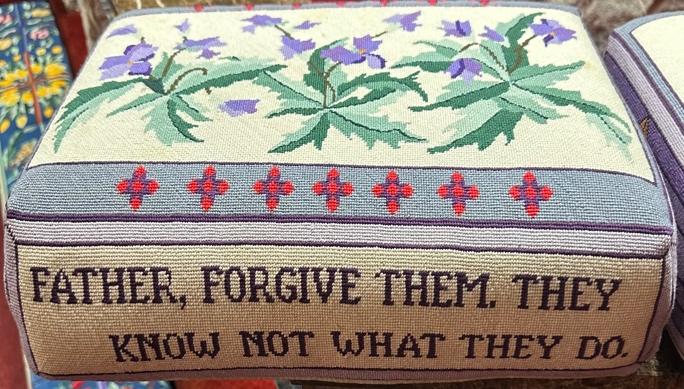
The violet is the symbol of humility, especially the description of Mary as the "violet of humility" by St. Bernard. It also refers to the humility of the Son of God in assuming human form
2. Today, I tell you, you will be with me in paradise.
Stitched by Anne Rusk
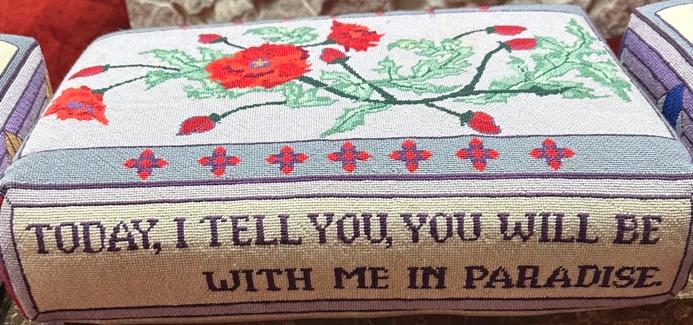
The poppy, long the source of opium, is a strong symbol of sleep. And its blood-red color depicts the Savior's suffering and death.
Given by Anne Rusk in thankfulness for the many blessings to her family.
3. Woman, behold thy son, son, thy mother.
Stitched by Robert Terry and Margie Roberts.
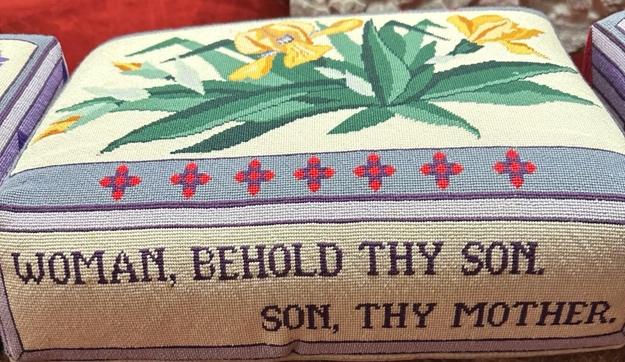
The iris, or "sword lily," is a strong rival of the lily among the Flemish masters. Here, it suggests the deep sorrow of Mary at the death of her son.
4. My God, my God. why hast thou forsaken me?
Stitched by Barbara McGinty.
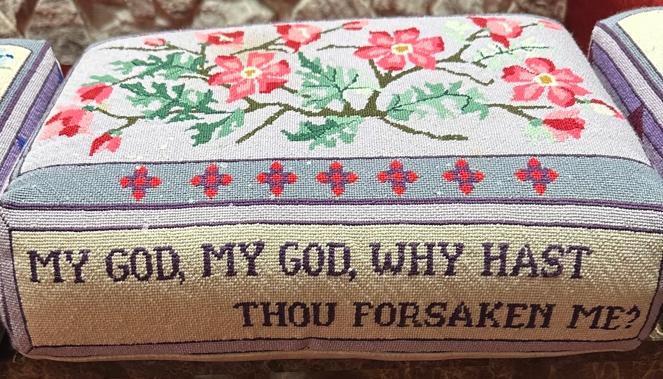
The red spots on the anemone represent the blood of Christ, for legend has it that anemones grew up on Calvary the evening of the Crucifixion.
Given by Barbara McGinty in loving memory of her parents, Ruth and Bill Knoth.
5. I thirst.
Stitched by Betty Tagger

Hyssop, which grows in rocky, solitary places represents patience. It is also a strong purgative which represents regained innocence. See Psalm 51: 7.
Given by Betty Taggert in honor of the baptism of her twin grandchildren, Haley and Dawson Taggert.
6. It is finished.
Stitched by Esther Timmeney and Doris Przeslawski.
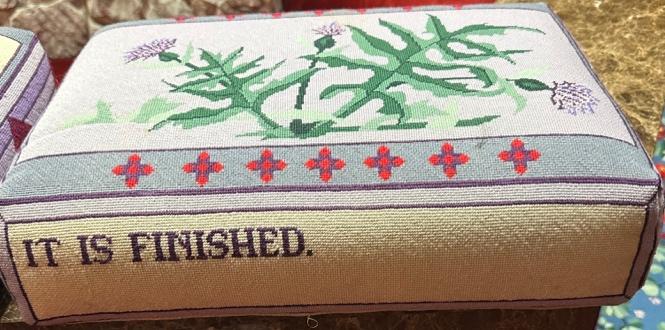
The thistle is a symbol of earthly sorrow. See Genesis 3: 17-18. Its thorny nature also represents Christ's crown of thorns.
7. Father, into your hands I commend my spirit.
Stitched by Patricia Bressler.
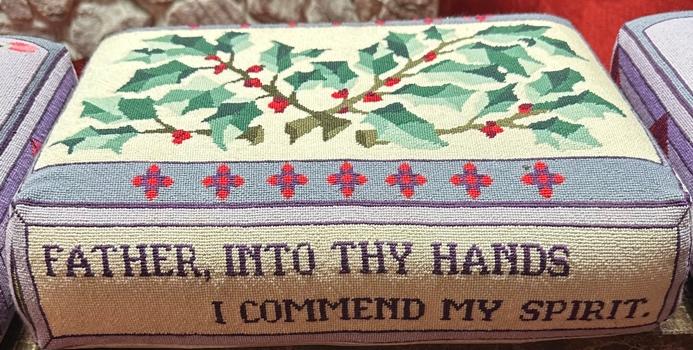
Commonly associated with Christmas, the ilex, or holly plant, is a strong symbol of the Passion. Its thorny nature goes to the crown of thorns. And legend has it that the holly was the only tree which would yield to the axe for the making of the cross.
Stitched with love and gratitude for my parents, my life partner, Doug, and our children, Gene, Laura and David. All thanks, praise, honor and glory to our Heavenly Father by Patricia Bressler.
The altar right. The Church Year represented by familiar hymn texts, floral and cruciform symbols.
1. Lo, how a rose ere blooming.
Stitched by Emily Cusie and Ardelle Fish.
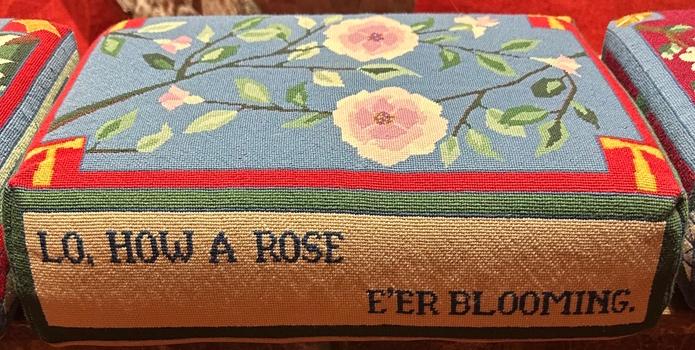
The flower is the simple, single rose, special to the Messiah. The cross is the Tau cross, that of expectancy, often found in the Old Testament.
2. Joy to the world, the Lord is come!
Stitched by Eileen Much.
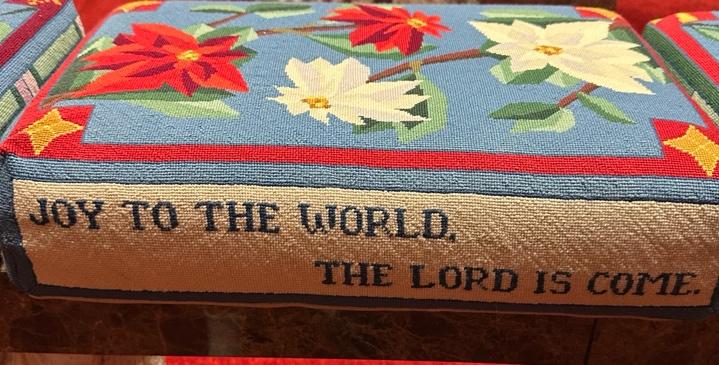
The poinsettia here is the only symbol which is not centuries old, being discovered in Mexico in the 19th century. It is, however, a beloved symbol of Christmas and deserving of inclusion. The star cross represents the Nativity.
Given by Robert Terry in loving memory of Janet.
3. Ah, Holy Jesus, how bast thou offended?
Stitched by Beverly Schweitzer.

The red spots on the dogwood (like the anemone) represent Christ's blood. And the legend goes that the dogwood, once a tall, stately tree which provided the wood for the cross, would afterward become dwarfed and gnarled, never having to do such a thing again. The barbed cross stands for the spear which brought forth water and blood.
Given by Beverly Schweizer in loving memory of her husband's parents, Karl and Gertrude Schweizer, and in honor of her parents, Charles and Celeste Benz, her husband Dick, and their five children and ten grandchildren.
Thanks be to God who gave us this talent to share for His glory.
4. Jesus Christ is risen today!
Stitched by Florence Staneff.
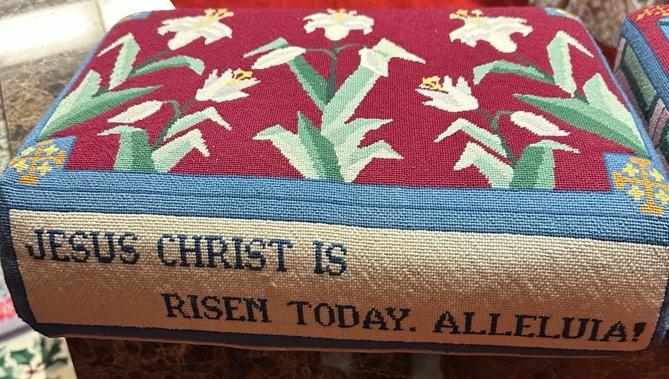
The traditional lily is perhaps the strongest flora1 symbol we have. In addition to the resurrection, the lily stands for the Annunciation, the birth of Christ, the purity of the Saints, and, as the fleur-de-lis, Christ's royalty. The Jerusalem cross stands for Christ's death and resurrection.
Given by Florence Staneff in memory of her husband, James.
5. Come, Holy Spirit, heavenly dove.
Stitched by Marge Akrep.
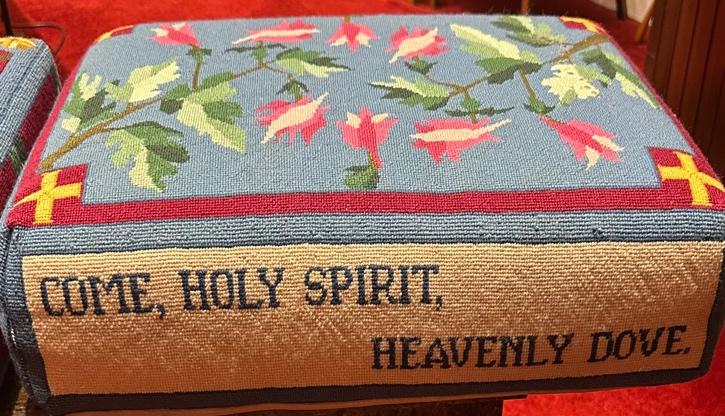
The columbine is so named because it is shaped like a dove (Columba in Latin). And the descending dove is one of our strongest symbols for the Holy Spirit Seven blooms on a stalk stood for the seven gifts of the Holy Spirit - see Isaiah 11: 2. The Greek cross, with arms of equal length, suggests that all are welcome to Christianity.
Given by Marge Akrep in memory of departed family members, and to the honor and glory of our congregation at Gloria Dei.
6. Holy, Holy, Holy! Lord God almighty.
Stitched by Elsie Dunlap.
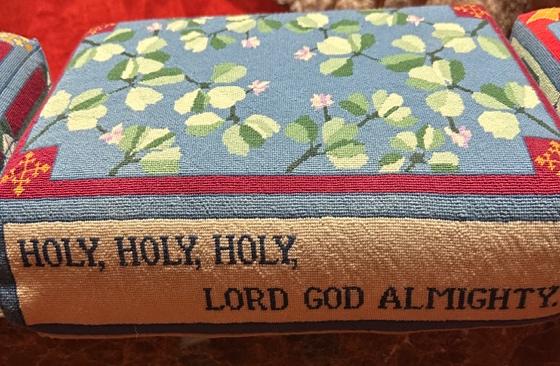
Clover, or trefoil, with its three leaves is a symbol of the Trinity - so given, some say, to St. Patrick when he evangelized Ireland. The cross botonee' here represents the natural inclusiveness of all in Christ.
The altar left: Psalm 1. That those who delight in the law of the Lord shall prosper, much like all the fruits depicted here which prosper, and which all grow in Florida.
1. Blessed are they...
Stitched by Robert Terry.
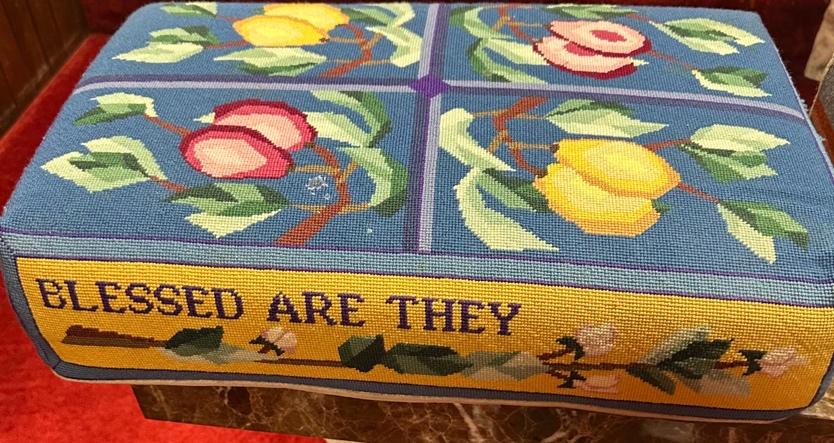
The pear is a symbol of the Incarnate Christ and his love for ail mankind.
Given by Louise Hoomstra in loving memory of her late husband, Dale Hoomstra.
2. Who delight in the law of the Lord.
Stitched by Margie Roberts.
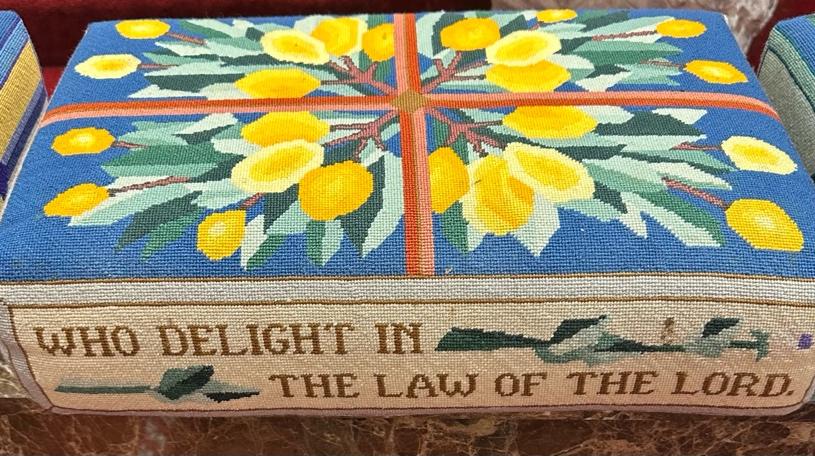
The lemon is a symbol of fidelity in love.
Dedicated by the Needlepoint Group in honor of Robert Teny whose talent and guidance made
possible this project.
3. They are like trees planted beside water.
Stitched by Ardelle Fish.
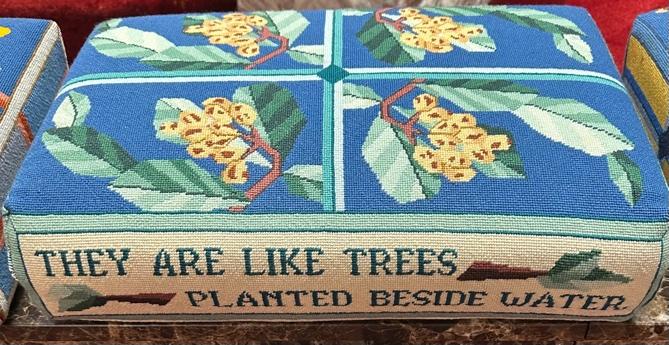
The plum (here the loquat which grows in Florida) represents strength and independence. Given to the Glory of God by Ardelle and Warren Fish.
4. They yield their fruit in season.
Stitched by T.C. Cusie and Florence Staneff.
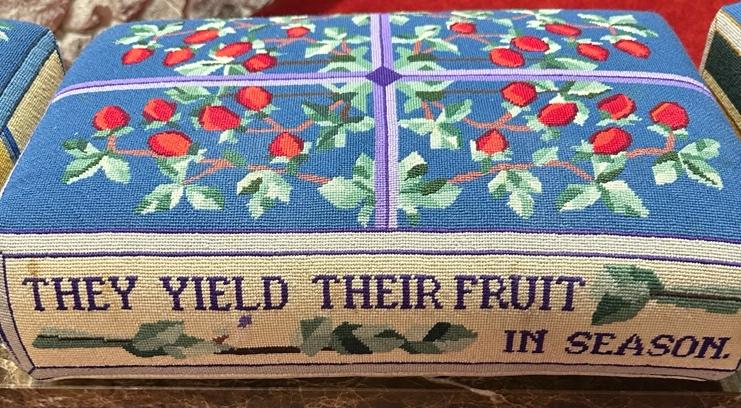
The strawberry is the symbol of perfect righteousness, or the emblem of one whose fruits are good works.
Given by Virginia Rogers in memory of her late husband, Donald Rogers.
5. Their leaves do not wither.
Stitched by Esther Timmeney.
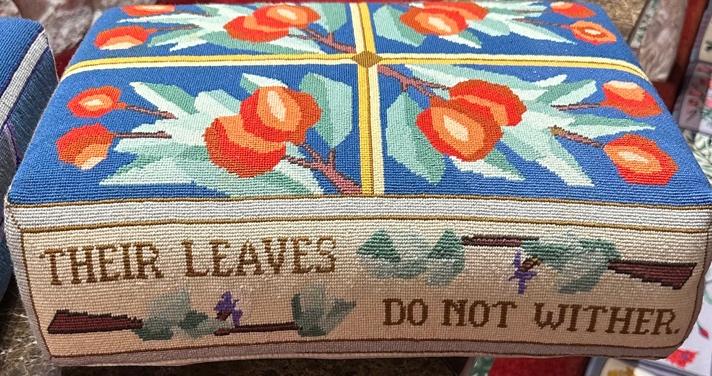
The orange, and its blossom, represent purity and, of old, were common in a bride's bouquet. It is also a symbol of generosity.
Given by Esther Timmeney in loving memory of all her departed loved ones.
6. They prosper.
Stitched by June Lee and Patricia Bressler.
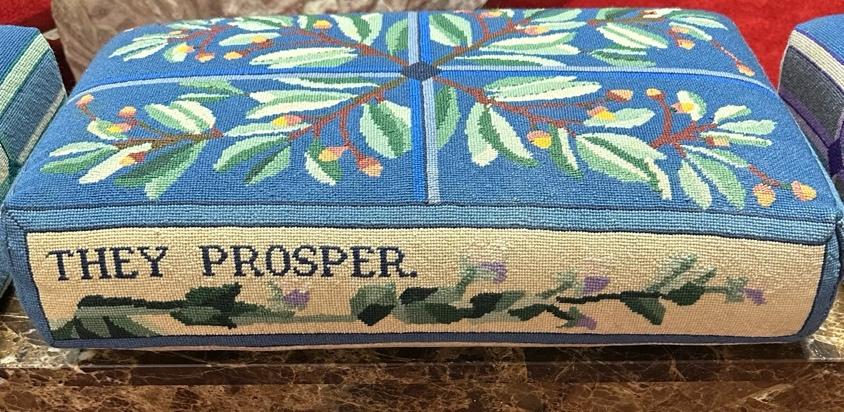
Long before Christ, the oak was revered for its endurance and solidity. For Christians, it became a symbol of strength. valor and perseverance in the face of adversity.
Given by June Lee in memory of Amos and Mathilde Smith.
